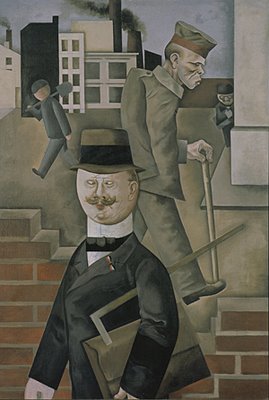
Yes, it's back to work for most of us drones, but for those of you still out there skiving, well done. You might want to pop along to the Metropolitan Museum of Art (or failing that, its Web site) to contemplate the exhibition "Glitter and Doom," which features Weimar portraits from the 1920s by such artists as Otto Dix, George Grosz, Max Beckmann, and Christian Schad. You can see all the classic Weimar types: prostitutes, profiteers, war-cripples, artists, musicians, Nazis, and nightclubbers.
A review by Mark Stevens in New York magazine says,
The (artists') worldview may be bitter, cruel, and vitriolic, but it's nonsense to suppose that their work is not also enjoyable. There is a wicked joy—and blessed release from piety—to be found in skewering the human animal and in refusing, occasionally, the invitation by Rembrandt et al. to be judicious, kindly, profound, and wise. Sometimes, screw 'em all.
He continues,
The situation in Germany between the wars was much worse than ours is today, but the dark eye of Weimar still beguiles our culture; it asks us to see through the masks of hypocrisy, platitude, and respectability. Imagine what Dix or Grosz would have made of the simian Bush, the feral Rumsfeld, the gloating bullfrog Cheney. Imagine how these Germans would have treated the Clintons, or Ted Haggard. How uncharmed they would be by the toothpaste smile of Tom Cruise. They would not have turned a blind eye on the Wall Street trough, where all our little piggies now feed.
Shown above: Grey Day, by George Grosz.

1 comment:
There is something really unnerving about those pictures from that period. I did my Open University long essay project on Otto Dix (following the big Tate show of his work back in 1992). Very strange bloke; very strange art.
Oh to be in New York!
Post a Comment